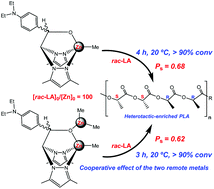Mono- and binuclear chiral N,N,O-scorpionate zinc alkyls as efficient initiators for the ROP of rac-lactide†
Abstract
The preparation of new chiral bis(pyrazol-1-yl)methane-based N,N,O-donor scorpionate ligands in the form of the alcohol compounds bpzampeH (1) {2,2-bis(3,5-dimethylpyrazol-1-yl)-1-[4-(dimethylamino)phenyl]ethanol}, bpzaepeH (2) {2,2-bis(3,5-dimethylpyrazol-1-yl)-1-[4-(diethylamino)phenyl]ethanol}, and bpzimeH (3) {2,2-bis(3,5-dimethylpyrazol-1-yl)-1-[1-methyl-1H-imidazol-2-yl]ethanol} has been carried out by the 1,2-addition reactions of a series of aldehydes. These new chiral heteroscorpionate ligands reacted with [ZnR2] (R = Me, Et, CH2SiMe3) in a 1 : 1 molar ratio in toluene to give the mononuclear monoalkyl zinc complexes [Zn(R)(κ3-NNO)] (4–12). When these reactions were carried out in a 1 : 2 molar ratio the binuclear trisalkyls [Zn(R)(κ2-NNμ-O)Zn(R)2] (13–18) were obtained. The structures of these complexes were elucidated by 1H and 13C{1H} NMR spectroscopy and the X-ray crystal structures of 4 and 5 were also established. Interestingly, alkyl-containing zinc complexes 4–13, 15 and 17 act as efficient single-component initiators for the ring-opening polymerization of rac-lactide at 20 °C to afford PLA materials with low molecular weights in a few hours. The dinuclear trisalkyls showed higher activity in comparison with the mononuclear zinc counterparts, suggesting a cooperative effect of the two remote metals. The narrow dispersity ranges (Mw/Mn = 1.05) of the isolated polymers in conjunction with the linear nature of the number average molecular weight versus conversion plot provided evidence for living behavior. Inspection of the kinetic parameters showed that the propagations have the usual pseudo-first-order dependence on rac-lactide and catalyst concentration. End-group analysis and MALDI-TOF mass spectrometry confirmed that the initiation occurs through nucleophilic attack of the alkyl on the lactide monomer. Microstructural analysis of poly(rac-lactide)s revealed that the most sterically hindered ligand on the alkoxide fragment exerts a moderate influence on the degree of stereoselectivity, with heteroenriched-PLAs (Ps = 0.68) produced at room temperature.



 Please wait while we load your content...
Please wait while we load your content...